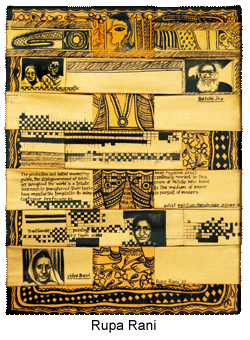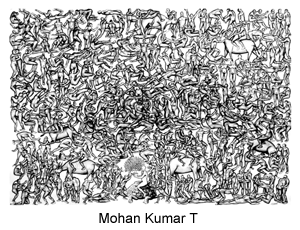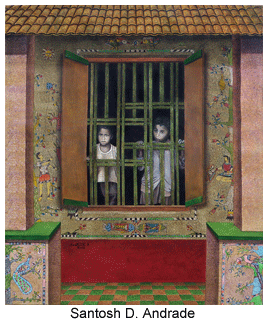- Prelude
- Hard Talk
- New Media
- Rolex : An Overview
- The age of Revivals: Neoclassical Furniture
- Democratization of the Medium No-Budget film: the Indian Context (!)
- Old Sound New Sound
- Decan Odyssey
- North East Opsis
- Russian cool breeze in hot Paris
- Around Kolkata
- Musings from Chennai
- In and around Santiniketan
- In between – from Vadodra
- A Tryst with Art in Madhya Pradesh
- Through the Looking Glass
- The Foreign Connection
- Market Insight
- Market Report
- Artist Index and Statistics
- Auction Reports
- The month that was
- Delhi Dias
- Art Bengaluru
- Mumbai Art Sighting
- Creative Impulse
- Subodh Gupta
- Pooja Iranna
- Preview
- In the News
ART news & views
Through the Looking Glass
Volume: 2 Issue No: 9 Month: 10 Year: 2010
Aspects of culture, in the wider sense, which were previously distinguished in an hierarchical manner are rendered equivalent as simulation. It is the trope of our times to locate the question of culture in the realm of the beyond. We are less exercised by annihilation- the death of the author- or epiphany- the birth of the 'subject'. Our existence and the present is marked by a tenebrous sense of survival, living on the borderlines of the present, for which there seems to be no proper name other than the current and controversial shiftiness of the prefix 'post': postmodernism, postcolonialism, postfeminism. The real and the imaginary- since the purpose of imagery is to remind us, by approximation, of those meanings for which the image stands, and since, apart from this, imagery is unnecessary for thought, we must be more familiar with the image than with which it clarifies.
Thus, the 'afterlife' of colonial discourse is very different for the colonizer and the colonized. The 'Other' no longer geographically distanced, but within, and over time significantly shaping landscape and culture. Not all places in the transnational circuit are however, similarly 'post-colonial'. The active, subjective, inescapable, everyday engagement of our living.  “It is one line of flight that these present day artists create tracing the real and consisting a plane of consistency, not simply imagining or dreaming”.(- Gilles Deleuze and Felix Guattari)
“It is one line of flight that these present day artists create tracing the real and consisting a plane of consistency, not simply imagining or dreaming”.(- Gilles Deleuze and Felix Guattari)
For some art practice is still priesthood not just confessional orgy. A large double bed with stained and rumpled clothes, a jar of oral contraceptives, a discarded condom, cow-dung smeared self portraits, annoys and excites at the same time. Some pithily comment it as conceptual art.
Considering what past Gen Next exhibitions have offered in the past quite elucidates the fact that its discernment of new promise and invoking a fresh discourse. It has also taken enormous care through exhibitions like 'Gen Next', to put contemporary Indian and International Art before the public in a balanced and coherent manner. The three artists discussed here Rupa Rani, Mohan Kumar T and Santosh Andrade has been chosen for this year's show consisting of 32 artists starting on October 2.
Rupa Rani meditates to return to contemplate few objects, icons, relics, photographs for keep sake, relics or mandalas. It is not on a variety of things she ponders, but on a few recurrent objects through which can be sensed underlying verities. Her paintings can be seen as meditation in which we viewers participate. In establishing her art practice Rupa Rani, an alumnus of Kala Bhawana, makes stirring references to two interconnected disciplines- archival documentation and semiotics that have become exceptionally important in the last two decades. Rupa Rani first drawings are therefore more diagrammatic before she sets out for her canvases. In these canvases the observer may view a single part, relate part to part, photographic images, view the area as a whole, or wander at random over it. The compositional plane is connected with a way of looking at objects and relating oneself to an object. She also reveals her desire for more direct and complex relationships with the audience and the establishment of rites of passage into muted familial history, memory, gender role and aspirations. With her work Rupa Rani moves openly into the field of impersonal and social behaviour: the spectators are asked to work with personal and social choices selected by the artist and the process demands a discussion. This has the benefit of deepening the immediate relation of her work and stretches the capacity of intertextuality.  The individual at the margins of a society creates a second reality. The quasi-caring and elite agencies become the unwitting repressors of individuality and creativity; individuals are forced back into archives, inside their homes or outside the 'newly real' world to express themselves.
The individual at the margins of a society creates a second reality. The quasi-caring and elite agencies become the unwitting repressors of individuality and creativity; individuals are forced back into archives, inside their homes or outside the 'newly real' world to express themselves.
Mohan Kumar T's position has not arrived at quickly nor was in the consequence of purely rational deliberation. Following his graduation from Ken School of Art, Bangalore he continued his work, using his newly gained privacy that contained a series of images that related almost in a diaristic fashion to the epoch around him. Motifs appeared and reappeared at intervals as he struggle to resolve on the paper with ink and charcoal and colour, worrying all the time about the dichotomy in his drawings. The dilemma was resolved theoretically but only when his feelings persuaded him of the rightness of adopting a representational style. At the end these two aspects are juxtaposed within a single plane, in the form of a dialogue. Although the various constituents of painting are overtly acknowledged, there is none of the cool literalism where the components have been distilled and then examined, for it is not the basic ingredients per se which fascinate Mohan Kumar. His focus is on the pivot, the point of transformation and the potential for revelation implicit in this metamorphosis.
He shifts to and forth simultaneously from large to relatively small formats, working with closer to the surface with a sense of intimacy in small and a sense of distance and space in large works that adds a sense of monumentality and markers used instinctively to stimulate the surface as in 'frenzy people' or 'can you find where you are?'- exclusive realm returns its pleasures to the enlivened physiques of its participants. Within the relatively quiet frame in 'opportunity extremes' there is intense activity; obviously, the energy made visible is controlled, and one has to watch closely the expressive visual modulation of space which are woven interlocking planes, which are so thin that they may go unnoticed. Engaging bodies that the images here as if retrieved from the times and spaces he has navigated inwardly and intensely with an indiscriminate abandon and unconfined. It is necessary for him that his painting follows an internal spontaneous spirituality and becomes a self-generating organism.
Santosh D. Andrade's work speaks calmly in virtue of a different stance, an authentic attitude. In his recent work done in acrylic on canvas, a greater complexity is evident, as the fragmentation between image and means becomes less intrusive, through a more supple and fluid handling, the more intricate spatial structure, and the more subtle use of light. Elegiac, almost melancholy, the mood of his work 'the courtyard of memories' imbues not only this theme, but great deal of his language. Yet the act of realization in itself allays resignation. These paintings gain not only their import but their power from this tension between subject and means, material and illusion, the actual and visionary. The horizontally cut ground establishes a locus, through not a plastic space for the reveller, and in this space as in that of the protagonist himself, the lighter toned strokes smear and lick the darker base, coming forward into visibility from the depths as nodal points wrested from the viscous inchoate structure.  Should the spectator approach in order to attain more precise information, the subject will dissolve. In reconstituting it the observer performs what is akin to a magical act. This is the crux of painting for Andrade, its emotional as well as metaphysical core: what he terms both a paradox and an act of faith; the establishing of a fiction which stands against and withstands other fictions.
Should the spectator approach in order to attain more precise information, the subject will dissolve. In reconstituting it the observer performs what is akin to a magical act. This is the crux of painting for Andrade, its emotional as well as metaphysical core: what he terms both a paradox and an act of faith; the establishing of a fiction which stands against and withstands other fictions.
Meaningful works like these hold such equal promise for us. Because we have experienced art only in the margins, we find ourselves not only alienated but alienated from our own alienation; without doubt we speak in a feeble tongue. We have exchanged our positions as critique of coloniality and the modern resulting meaningful discourses. The images here are replete with images retrieved from the times and spaces, Andrade has navigated inwardly and intensely with an indiscriminate abandon, unconfined- its pleasures to the enlivened physiques of its participants. The painting itself is completely changed, from the colours to the space occupied, the immediate interest focused on the drama of the event itself, but the ambiguities inherent in the representations of right and wrong, and the different meanings that different disciplines invest them do also occupy him. In the communication of both the existential and the common, creativity remains a primary vehicle due chiefly to its protean, questioning qualities.
This is ritualization, socialization, fresh discourses, fresh struggles, the generation of institutions that minimize violence through codification and repetition. Here is domain of cultural poiesis. We shuttle between the different spaces, dividing into partisan, watching selves as we do: each mode captures an aspect of the idea, and the complementary versions overlap. The eclecticism of visuality that led up to the piling of some images here from diverse visual sources on one visual space as this exhibition, brought to effect an ambivalent language of collage and citation facilitating juxtaposition of Indian and Western, traditional and modern, national and subaltern, sacred and erotic elements, between the mythical and colonial, between celestial and terrestrial, shifting of locales and characters, transfer from one time, place and genre to another, on a single receptor surface and a mode of contemporary articulation of an anti-colonial allegorical and metaphorical infrastructure in place for politics and living. Otherwise, the legacy is simply there, as printed word, as aesthetics, as historical monuments to a dated romanticism, once alive but now cold and dead. In this mode, they can only be revived as merely as one artist's personal sentiments. To proclaim an individual sentiment as something political would indeed be sentimentalism.